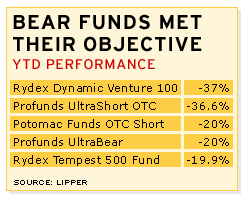NEW YORK (CNN/Money) -
There's been one sure way to lose money this year in the stock market: Bet against it.
In the Standard & Poor's index of 500 large stocks, 385 of them, or 77 percent, are higher this year. Meanwhile, mutual funds designed to profit from a falling market are enduring double-digit percentage declines.
After enjoying big gains since the stock market began a three-year slide, so-called bear market funds finally may be proving the difficulty of making money in a market that tends to rise over time.

"Over the long haul, it's almost certain that these will be a losing bet," said Russ Kinnel, editor of mutual funds at fund-tracker Morningstar.
That's been the case this year. Take the Rydex Venture 100 Fund (RYVNX: Research, Estimates), which uses options and futures contracts to deliver investment returns that double the inverse of the Nasdaq-100. Mission accomplished. The fund is down 37 percent this year, a period when the Nasdaq-100 is more than 19 percent higher.
A fund with the same objective, the ProFunds UltraShort OTC (USPIX: Research, Estimates), is down nearly 37 percent in 2003.
While a rally that has pushed the S&P 500 up 22 percent since Oct. 9 has hurt bear funds, their managers are confident that better times, or more stock market declines, lie ahead.
"We're very bearish," said Charlie Minter, who co-manages the $106 million Comstock Capital Value (DRCVX: Research, Estimates) fund, which is down 13 percent this year following a 36 percent rise in 2002.
A short-seller who believes stocks are overvalued, Minter has been selling borrowed shares of technology and financial stocks on the hope he can buy them back at lower prices and pocket the difference for investors.
Minter is betting that the foreign investors who poured money into U.S. market in the last decade are not done retreating from it. And he's worried about an economy where consumers are heavily in debt and businesses are neither hiring nor buying new equipment.
Short-lived stock market rallies have punctuated the three-year market decline that begin in early 2000.

"We believe that this is the same thing," Minter said of the run that began in October. He said the S&P 500 could fall to 600, a 37 percent drop from Thursday's 949.64 close.
David Tice, whose $439 million Prudent Bear Fund (BEARX: Research, Estimates) is down 11 percent this year, expects that the bear market's length will parallel the duration of the last bull market, which many say began in 1982.
"Bear markets reflect the purging of excesses created in the previous boom times," Tice writes on his fund's Web site, www.prudentbear.com.
Bill Gross, who manages the Pimco Total Return bond fund, might agree. Gross last year predicted the Dow Jones industrial average could fall another 40 percent to 5,000 because the stock market remains stubbornly expensive.
Small universe
The world of bear funds remains a small one, with only about 19 funds that all hold less than $500 million in assets apiece. Still, Morningstar considers them important enough to begin officially tracking the category starting next week.
Rydex and ProFunds dominate the group that often charges higher fees than the average mutual fund while requiring higher minimum investments.
Russ Kinnel, the Morningstar editor, cautions investors against putting more than 5 percent of their total assets in one of these funds, which he says nonetheless can play a role in hedging stock-heavy portfolios against the risk of a declining market.
He also warns that investors generally are not successful in timing these funds, moving in after gains and pulling out just as the losses are ending
Still, Kinnel could not resist suggesting a way for investors to bet against the bond market, which has rallied for the last three years.
For that purpose, he likes Rydex's Juno Fund (RYJUX: Research, Estimates), which is designed to generate returns that will inversely correlate to U.S. Treasury debt.
The Juno fund is down nearly 8 percent over the last three years.

|

